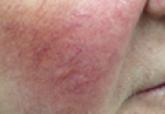Blog

Red Is Wrong; In the Red Also Is Wrong
A recent study in the Journal of Drugs in Dermatology (2014;13:56-61) featured long-term data regarding use of brimonidine gel, which was...
From the Division of Dermatology, University of Louisville, Kentucky, and Dermatology Specialists Research LLC, Louisville.
Dr. Fowler is a consultant and researcher for Allergan, Inc, and Galderma Laboratories, LP.
Correspondence: Joseph Fowler Jr, MD, 501 S 2nd St, Ste 100, Louisville, KY 40202-1899 (fowlerjoe@msn.com).

Rosacea is a common chronic disorder that predominantly manifests as facial erythema, telangiectasia, and flushing. Other primary clinical features include inflammatory lesions (eg, papules, pustules) and occasionally edema and rhinophyma. Ocular involvement also may occur. Although a number of options are available to successfully treat inflammatory lesions of rosacea, facial erythema has been the most difficult manifestation of the disease to medically treat.
Rosacea is a common chronic disorder that predominantly manifests as facial erythema, telangiectasia, and flushing.1 Other primary clinical features include inflammatory lesions (eg, papules, pustules) and occasionally edema and rhinophyma. Ocular involvement also may occur. Rosacea patients routinely report sensitive skin with symptoms such as stinging, burning, and intolerance to topical agents (eg, medications, moisturizers, cosmetics).2,3
Rosacea affects facial appearance and can impair a patient’s emotional well-being. It may limit social and professional activities. Many patients and nonpatients alike presume the appearance of facial redness suggests alcohol overuse or emotional distress.4-6 A reduction in facial erythema as well as improvements in other clinical signs of rosacea have been shown to reduce patient self-consciousness and lead to increased socialization.7 Facial erythema is a major factor that adversely affects quality of life in rosacea patients.8
Although a number of options are available to successfully treat inflammatory lesions of rosacea, facial erythema has been the most difficult manifestation of the disease to medically treat.2,9 Chronic erythema and episodic flushing may be at least partially related to cutaneous vasomotor responses causing both transient and persistent dilation of facial blood vessels.10-12 The agents used for treating the inflammatory components of rosacea reduce erythema associated with papules and pustules but have little effect on the background erythema that is so noticeable. Oxymetazoline and brimonidine tartrate have been evaluated as potential rapid treatments of facial erythema. Daily application of oxymetazoline solution 0.05% has been shown to reduce facial erythema in rosacea patients.13
Brimonidine tartrate is a highly selective α2-adrenergic receptor agonist with potent vasoconstrictor activity.14 It has been used to treat open-angle glaucoma for more than 15 years with well-documented safety and efficacy.15 Phase 2 and 3 studies for once-daily application of brimonidine tartrate gel 0.5% have confirmed its efficacy and safety for the treatment of facial erythema in rosacea patients,9,12 and it was approved by the US Food and Drug Administration (brimonidine gel 0.33%) for persistent (nontransient) facial erythema of rosacea in late 2013. The effect was shown to occur in some patients as soon as 30 minutes following product application and usually persisted for approximately 9 to 12 hours. Erythema gradually returned as the effect waned, returning to baseline by 24 hours after application.12
Clinical efficacy of brimonidine gel was evaluated by a 2-grade improvement (primary end point) or 1-grade improvement (secondary end point) based on patient and clinician assessments using the patient self-assessment (PSA) and clinical erythema assessment (CEA), respectively, over the course of the 4-week studies. Patients also evaluated their satisfaction with the overall appearance of their facial skin.12 A 2-grade improvement on both PSA and CEA has been noted as a stringent criterion in evaluating the effectiveness of treatment of facial erythema.14 A 1-grade improvement on both PSA and CEA has been recognized as clinically relevant as a measure of effect that is noticeable to both patients and clinicians.12 Patients who achieved either a 1- or 2-grade improvement in both PSA and CEA were substantially more likely to report overall satisfaction with their appearance. A 2-grade improvement in both PSA and CEA scales was accompanied with 80% of patients rating their skin appearance as satisfactory or better. Conversely, few patients (ie, <10%) who did not achieve at least 1-grade composite success were satisfied with their appearance. Adverse effects were uncommon, with no evidence of tachyphylaxis and rare occurrence of rebound erythema.12
In summary, although there are a number of options available to reduce or eliminate inflammatory lesions of rosacea, effective medical treatment of the erythematous component of rosacea, which can be the most distressing aspect of the disease for patients, has been unsatisfactory. With the availability of topical brimonidine tartrate, dermatologists have a proven medication to improve facial redness in rosacea patients. Other options such as oxymetazoline may become available in the future.

A recent study in the Journal of Drugs in Dermatology (2014;13:56-61) featured long-term data regarding use of brimonidine gel, which was...

Rosacea is a common clinical diagnosis that encompasses a variety of presentations, predominantly involving the centrofacial skin. Reported to...
Leading dermatologists offered their recommendations on the top redness-reducing products. See what they’re recommending to their patients and why...
Our understanding of the pathophysiology of acne and rosacea continues to evolve, leading to new therapeutic targets and the development of...
